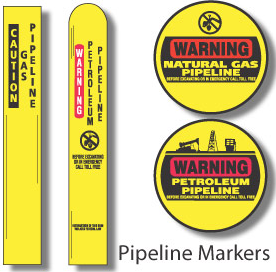Safety Precautions
Odorization
Natural gas is a colorless, odorless gas, so an odorant, typically mercaptan, is added to the gas stream as an additional safety mechanism. Odorization of natural gas, in Interstate and gathering transmission systems, is regulated under Title 49, part 192 of the Federal Code of Regulations. This code requires transmission lines in highly populated areas (Class 3 and 4 locations) to be odorized. High-consequence areas are subject to added layers of regulation to ensure public safety. “Class location” is a term used in the regulations to denote the population density surrounding the pipeline. Class location is determined by the number of dwelling units within 220 yards in a sliding mile of the pipeline. Classes 3 and 4 are those locations with 46 or more buildings or a building occupied by 20 or more persons at least five days a week for ten weeks (schools, community centers, etc.). Transportation pipelines in Class 1 and 2 locations—rural areas with fewer than 46 buildings per sliding mile—are exempt from the odorization regulations. On a practical basis, the gas that is odorized for a Class 3 or 4 location “upstream” will retain some level of odorant in the gas stream as it travels through Class 1 and 2 areas.
Class Locations
Most PHMSA and/or state regulatory agency inspection protocol are based on the pipelines ‘class location’. Class 3 and 4 areas are places where there would be greater human injury potential from a pipeline incident and require a more rigorous inspection regime. Class locations are checked routinely and revised based on new residential development occurring in an area.
Class Locations are:
- Determined by the number of buildings within 201m on each side of pipeline per 1.6km
- Class 1 location - 10 or fewer buildings
- Class 2 location - more than 10 less than 46
- Class 3 and 4 locations - more than 46 buildings and buildings with occupancy (churches, schools, etc.)
- Added layers of regulation in higher consequences areas
Pipeline Identification
Pipeline markers are located along the path of a gas pipeline. These markers identify the general location of the pipeline and list the products transported, the operator’s name, and the emergency contact number. Pipeline markers do not identify the exact location of the pipeline, so it is critical that landowners contact the One Call System before any excavation near the pipeline easement. This is also why landowners should insist in their negotiations with pipeline companies that the landowner receive an “as built” survey showing the precise location of the as-constructed pipeline within a stated period immediately following the completion of pipeline construction.

Right-of-Way Maintenance
Pipeline operators will regularly conduct aerial and ground inspections to check right-of-way conditions, test for leaks, install and maintain pipeline makers, and clear brush that restricts access to the right-of-way or visibility during inspections. Rights-of-way are kept clear of trees, brush, and other obstructions so the pipeline operator can safely operate, inspect, maintain, and repair its pipelines. The easement usually provides for ingress and egress rights to the pipeline company. This can create problems for landowners who keep cattle, horses, and other animals on land across which an easement runs. The pipeline company may come onto the easement without prior notice and without care to keep all gates shut, except for entering and leaving the property.